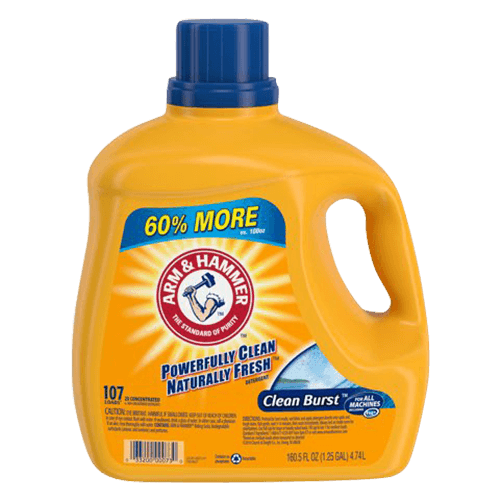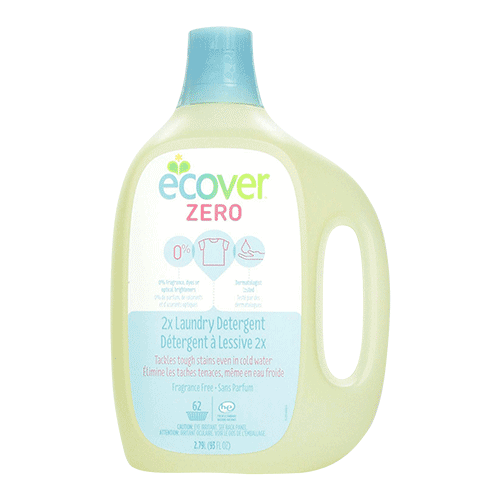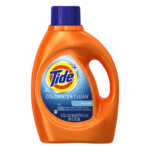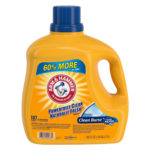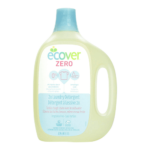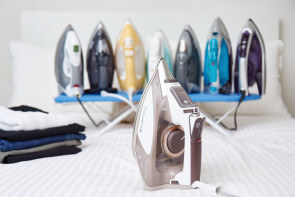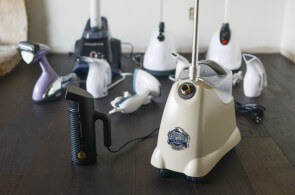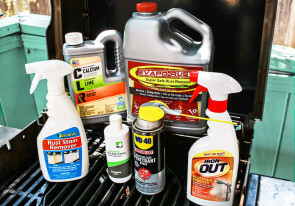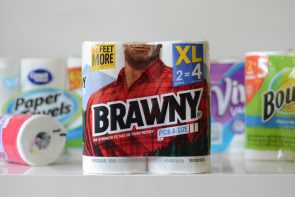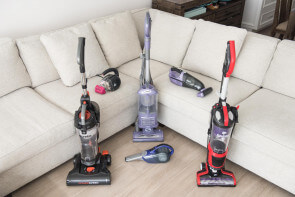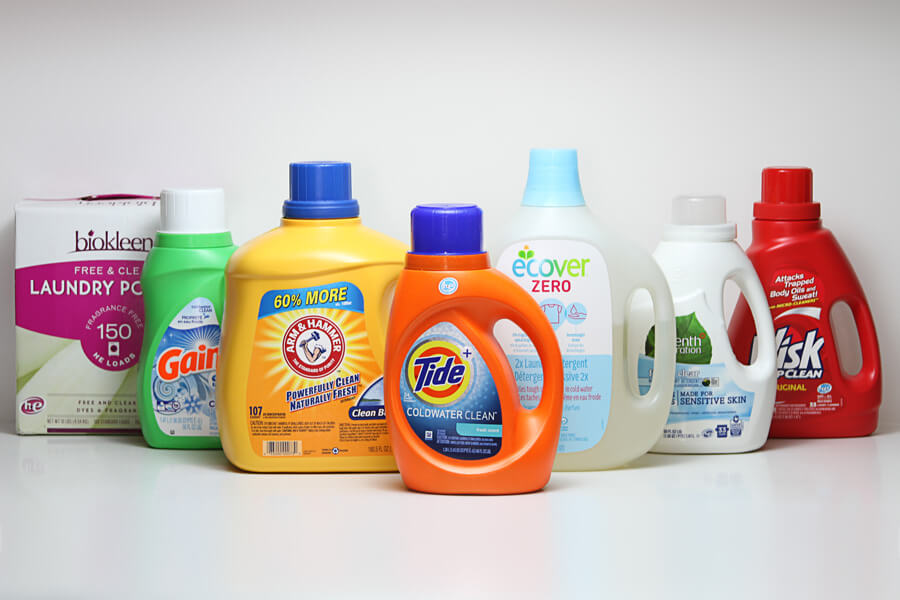
The Best Laundry Detergents
We spent more than 45 hours on research and in-home testing to determine which of the top-rated laundry detergents on the market outperformed the rest. Our findings lead us to recommend Tide – Coldwater Clean as the best laundry detergent available. It made our clothes come out brighter and smelling terrific, and best of all, this was achieved by washing in cold water. We found that Tide Coldwater gives the most bang for your buck.
We spent more than 45 hours on research and in-home testing to determine which of the top-rated laundry detergents on the market outperformed the rest. Our findings lead us to recommend Tide – Coldwater Clean as the best laundry detergent available. It made our clothes come out brighter and smelling terrific, and best of all, this was achieved by washing in cold water. We found that Tide Coldwater gives the most bang for your buck.
Table of Contents
- The 8 laundry detergents we tested
- Best overall: Tide – Coldwater Clean
- Most cost-efficient: Arm & Hammer – Clean Burst
- Best natural detergent: Ecover – Zero
- Other products we tested
- How we selected
- How we tested
- Important features to consider
- Liquid vs. powder detergent
- High efficiency (HE) washing machines
- The bottom line
The 8 laundry detergents we tested

| Product | Cost Per Load (lowest from Amazon, Target or Walmart) | Sensitive Skin Safe (no dyes / perfumes) | Natural / Eco-Friendly | Cold Water |
|---|---|---|---|---|
| Tide - Coldwater Clean | $0.20 | no | no | yes |
| Arm & Hammer - Clean Burst | $0.08 | no | no | no |
| Ecover - Zero | $0.23 | yes | yes | yes |
| Wisk [Discontinued] | $0.17 | no | no | no |
| Biokleen - Laundry Powder | $0.11 | yes | yes | no |
| All - Free and Clear | $0.29 | yes | no | no |
| Gain - Oxi Boost | $0.19 | no | no | yes |
| Seventh Generation - free & clear | $0.18 | yes | yes | no |
Best overall: Tide – Coldwater Clean
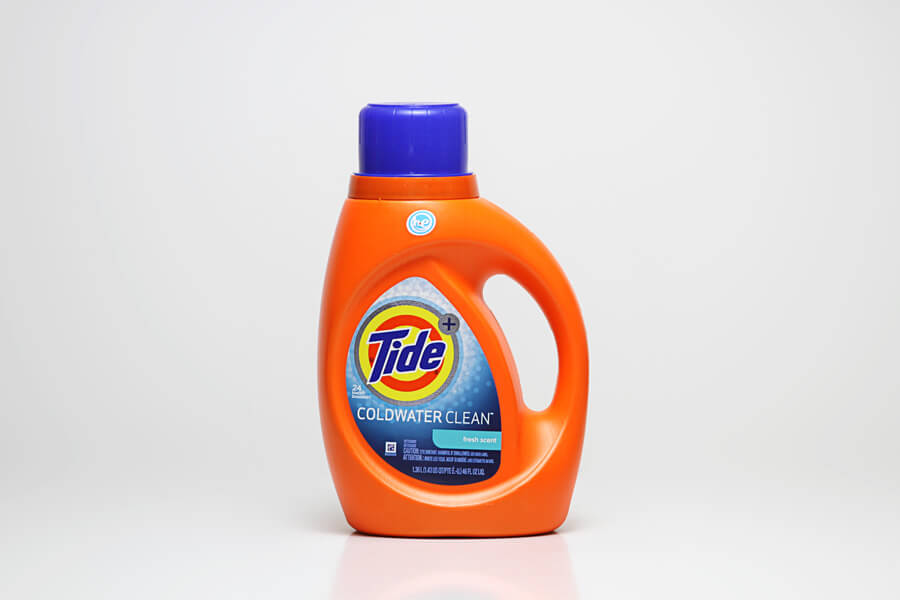
The U.S. Department of Energy reports that 90% of the energy used by clothes washers is for heating the water. In addition to saving money on energy bills, washing in cold water gives better color protection (prevents fading) with less chance of dye transfer onto other clothes. We were really impressed by the ability of Tide – Coldwater Clean to remove stains and brighten clothes in cold water.
Of the three cold-water formulas we tested, Tide – Coldwater Clean performed the best in cold water conditions. In terms of stain removal, it beat out six of the other detergents and tied with Wisk Deep Clean, which needed warm water to do the job. It can also be used in warm or hot water, making it a versatile option for those who prefer cold water for delicates and warm water for messier clothes.
With 70% of Amazon reviewers and 66% of Walmart buyers who used Tide – Coldwater rating it five stars, we weren’t alone in our findings. In fact, it was highly rated with consumers who wash cloth diapers for its performance in removing both stains and odors. The negative reviews mainly related to the scent, however, there were a few reports of dye remaining on the clothes. We didn’t experience this, and because the dye is water-soluble, it can be removed with hot water.
If you own a HE washing machine, you’ll appreciate the HE TurboClean technology that P&G introduced in 2015 and is available in the Tide – Coldwater Clean formula. It uses quick-dissolving suds that prevent HE machines from running additional rinse cycles, which can save up to 10 gallons of water, not to mention your valuable time.
Key takeaways:
- Our top stain fighter, Tide – Coldwater Clean not only performed better than the other three cold-water detergents, it removed stains more or equally as effectively as all the detergents we tested in warm water.
- An excellent detergent for a middle-of-the-road price, the energy you save by washing in cold water will also reduce your electric bill.
- Tide Coldwater Clean features HE TurboClean technology, a proprietary formula that quickly collapses suds and targets tough stains.
Most cost-efficient: Arm & Hammer – Clean Burst
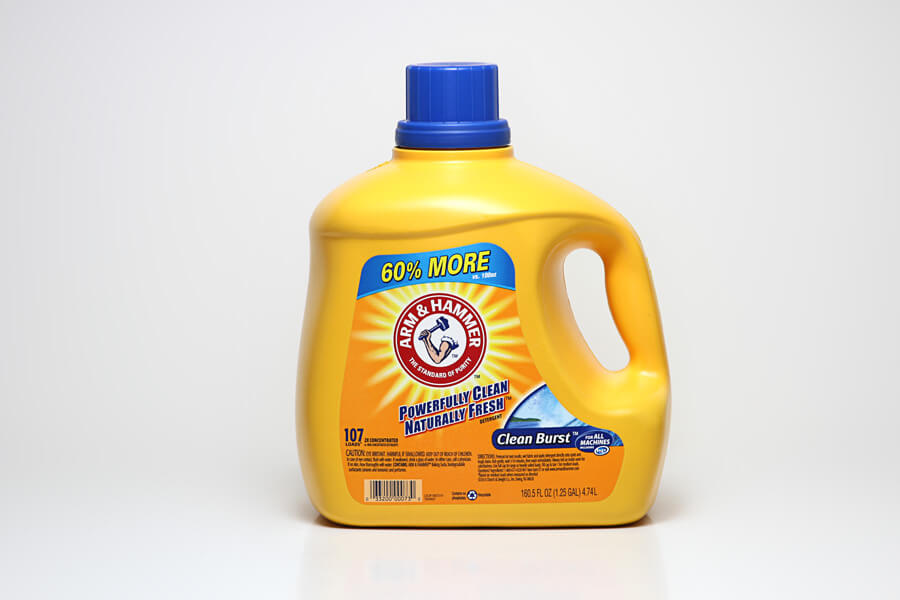
When it comes to a bargain detergent, Arm & Hammer – Clean Burst is hard to beat at only eight cents per load. Price is a number one factor for many families, so it’s no surprise that this detergent receives great reviews on Amazon.com (57% give it five stars) and Walmart.com (79% give it five stars). In addition to an excellent value, consumers are also drawn to its long-lasting fresh scent and gentle yet effective cleaning capability.
Formulated with baking soda, this detergent is designed to power out odors and freshen clothes. It works well on protein-based stains like egg and grass, but struggles with some of the tougher stains. While not the best option for stain removal, it doesn’t cause any unusual wear and tear on fabric, which can often be the case with inexpensive detergents.
One YouTube reviewer suggested Arm & Hammer – Clean Burst as a good alternative to Tide (which can be pricier), thanks to its fresh scent and ability to get clothes clean without adding boosters or bleaches.
Key takeaways:
- Giving you more detergent for less money, Arm & Hammer is a great option for households that wash multiple loads of laundry each week or just want to save money.
- The natural freshening and deodorizing power of baking soda, combined with a lingering scent, make this detergent a great choice for those who love the smell of fresh linen.
Best natural detergent: Ecover – Zero
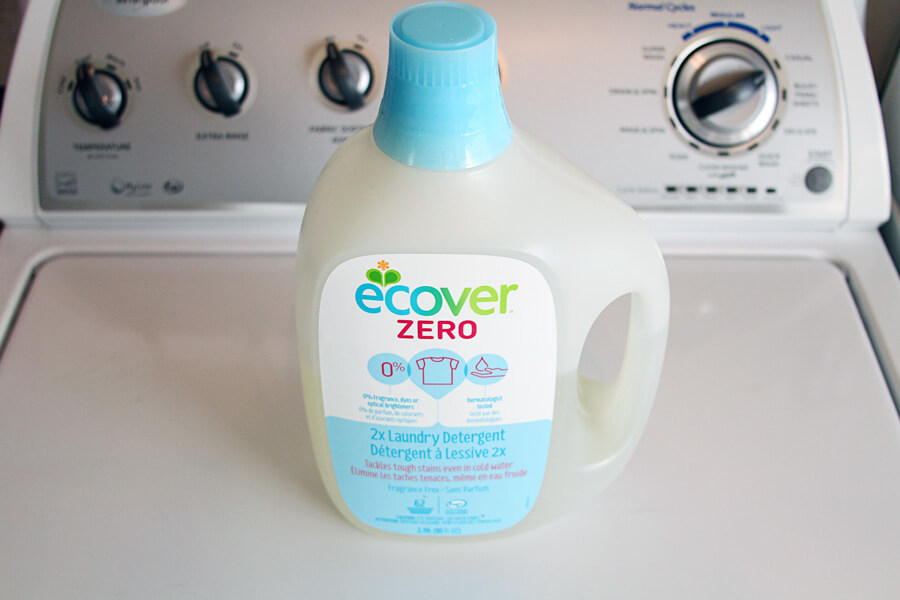
While the eco-friendly or natural detergents were less effective at removing stains, we couldn’t get enough of how soft our laundry felt after washing it in Ecover – Zero laundry detergent. It contains a plant-based fabric softener that works well on natural fibers but can reduce absorbency in towels. We loved it on our sheets, and it was nice to know that the fabric we had next to our skin all night was washed in a detergent that has met the highest standards for safety and environmental impact.
Ecover scored an A rating in the EWG’s Guide to Healthy Cleaning and has met a thorough list of requirements to be Green Certified by Whole Foods Market. Their ingredient disclosure is good, and the biodegradable formula (made from plant-based ingredients) is packaged in a bottle made with recycled plastic and plastic made from sugarcane.
Not only is Ecover eco-friendly, it’s formulated to be washed in cold water so it’s energy-efficient as well. However, we recommend a warm water wash when you need to remove set in stains.
Key takeaways:
- According to EWG, Ecover – Zero is formulated with few or no known/suspected hazards to health or the environment.
- Completely free of fragrance or dyes and tested by dermatologists, this detergent is an excellent choice for those with sensitive skin.
Other products we tested
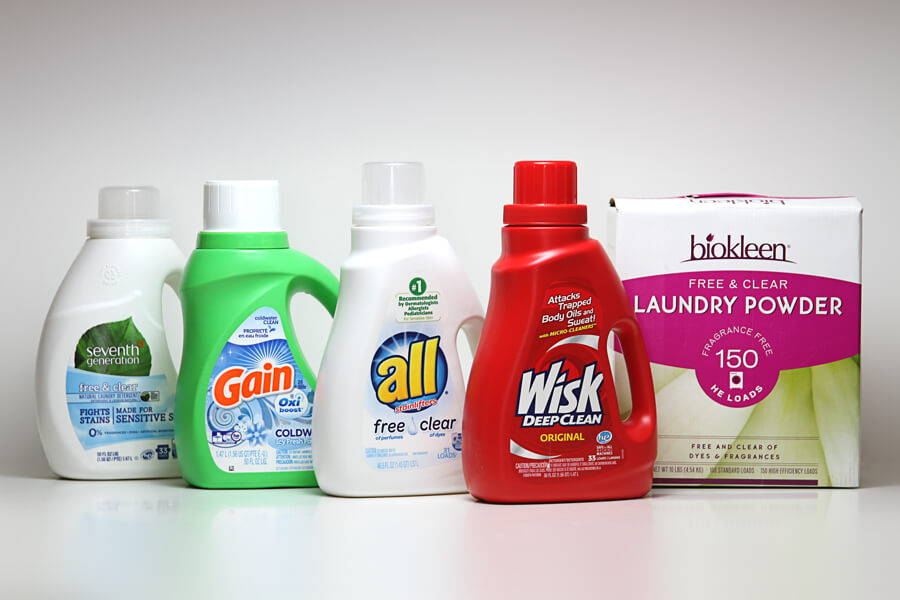
All – Ultra Free and Clear
A premium detergent, All – Free and Clear is highly recommended by reviewers for those with sensitive skin. It has been awarded the NEA Seal of Acceptance by the National Eczema Association, and removes everyday and seasonal allergens such as pet dander, dust mite matter, and pollen. Even without a harsh formula, it still rated well in our stain removal test. Some consumers balked at the cost, but for those with sensitive skin, it was well worth the price.
It does contain sodium cocoate, which reduces allergens in clothing, but is a soap that can build up at too high a concentration. It’s also a no go for absorbent items like towels, since it can coat fibers and cause water repelling issues when you later use it to dry off. It also contains optical brighteners, which may cause issues for those with sensitivities.
Biokleen – Free & Clear Laundry Powder
Biokleen is another eco-friendly choice that scored an A rating on EWG’s Guide to Healthy Cleaning, indicating the lowest concern for suspected hazards to health or the environment.
All Biokleen products are free of chlorine bleach, synthetic colors, or artificial fragrances, and the Free & Clear is the company’s most popular option. It is formulated with a basic set of ingredients such as sodium carbonate, surfactant, and hydrogen peroxide, and Biokleen has received kudos for their good ingredient disclosure.
As a powder detergent, Biokleen does not dissolve in cold water (it could leave white streaks) and like the other eco friendly detergents we tried, it doesn’t fully remove stains. However, as the most inexpensive of the eco-friendly detergents we tested (and second most inexpensive of all our finalists), it’s a practical choice for those looking to protect their health and the waterways.
Gain – Icy Fresh Oxi Boost
With the cleaning power of Oxi (oxygen bleach) and a lingering scent that locks in to keep your clothes smelling fresh longer, reviewers on Walmart.com nearly unanimously gave Gain – Icy Fresh Oxi Boost a five-star rating. It is optimized for use with cold water, and the clothes we tested came out clean and bright, although it didn’t remove stains as well as the Tide Coldwater.
The selling point for most purchasers is the Icy Fresh Fizz scent, which is described as clean and invigorating, and the Oxi Boost, which helps to get clothes brighter without the need for hot water. It also contains enzymes, so this detergent is especially effective on bleachable and protein stains.
Seventh Generation – Free & Clear
Of the three eco-friendly laundry detergents we reviewed, Seventh Generation was the best at removing stains and freshening clothes. Although it does not contain optical brighteners, dyes, fragrance, or phosphates, it only scored a C rating from EWG due to its use of methylisothiazolinone. On the other hand, it has met the Environmental Protection Agency’s Safer Choice Standards since 2009.
Balancing green certification with a decent stain-fighting ability and a reasonable price, this detergent is a good option for those who want an eco-friendly detergent that doesn’t require extra pretreating steps.
Wisk – Deep Clean
Wisk – Deep Clean was excellent at removing stains, left our clothes smelling great, and reasonably priced at only .17 cents per load.
Sadly, it’s all but discontinued after the brand was sold to Sun and then Henkel. The replacements are the less-expensive Purex and more-expensive Persil. Those who loved Wisk but dislike the new scent or have a reaction to the detergents in Persil are advised by the new owners to try the sensitive skin formula.
How we selected

Our research phase began by checking out online reviews from retailers like Amazon.com, reading through blog articles and subreddits like /r/howtodolaundry, and watching YouTube video reviews. This gave us an idea of what consumers look for in a laundry detergent, so we could form some key metrics to use for comparison. It also allowed us to narrow down a vast selection of laundry detergents to eight finalists.
Then we delved into the science behind laundry detergent in order to decide which tests would help us determine the best laundry detergent. Last but not least, we headed to the laundry room with our eight finalists and loads of dirty clothes that included sheets, towels, and the toughest of all laundry tasks — toddler laundry. In this way, we could see how well each detergent handled food stains and ground-in dirt, while keeping our sheets soft and our towels absorbent.
How we tested
The stain test
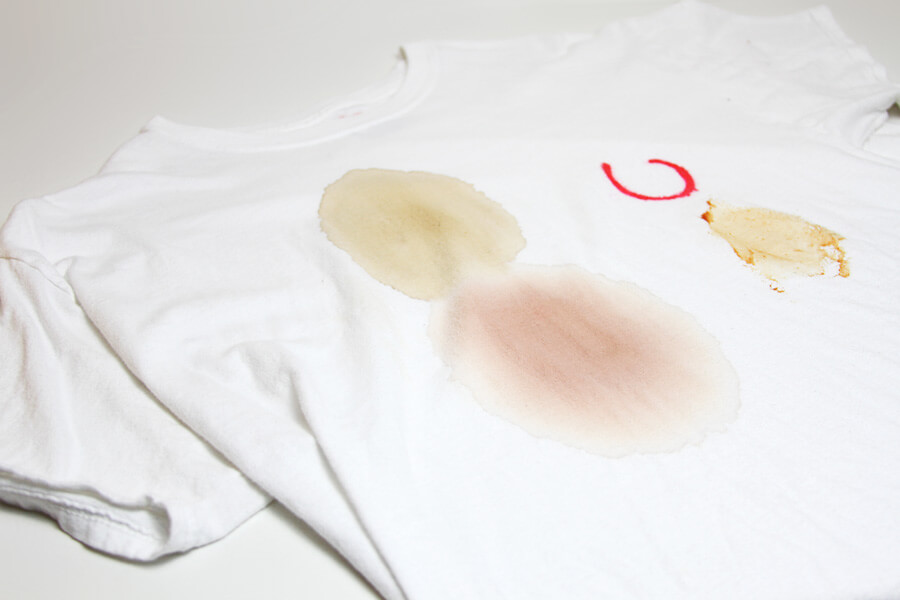
The science behind stains gives you a good idea of how to treat specific stains. For example, proteins like blood and egg are best removed with a protease enzyme to digest protein stains. For a laundry detergent, the goal is to remove the widest variety of soils and stains. Starting with a detergent that is an effective stain remover saves you time and energy. You’ll only need to pre-treat and soak the most stubborn stains.
In order to find out which detergent was the best at removing stains and brightening fabrics in general, we took eight 100% cotton Hanes – classic t-shirts and stained them with four different types of common stains.
Bleachable: Since you’re just waking up, the first cup of coffee of the day is bound to end up on your clothes. Coffee (and tea) stains are considered a bleachable stain, which means these stains are removed with an oxidizing agent or bleach.
Oil: Oils and grease stains usually come from food. Since real life tends to be be more complex than dealing with a simple stain, we created a combination stain of oil and bright dye with a red lip gloss.
Carbohydrate: You may have noticed that carbohydrate stains such as ketchup seem preternaturally attracted to white t-shirts. We painted our t-shirts with a blob of ketchup to see how well our detergents would remove one of the more prevalent types of stains.
Tannin: Tannin stains like red wine and fruit juice can be tricky to remove. We applied two tablespoons of red wine to each shirt to see how the detergents would fare.

We let each of the stains set overnight, because realistically, most of us don’t wash our laundry every day and stains on our clothes are most likely to have dried before we get around to washing them out. For the detergents that with formulas that worked in cold water, we washed them in cold water first. Then we washed them a separate time in warm water. The rest of the detergents were washed in warm water.
During the month of testing, we found ourselves gravitating toward Tide – Coldwater when it came to washing loads with tough stains. It lightened the bleachable and tannin stains and removed the carbohydrate stain, all in a cold water wash. Washing in warm water lightened the stains even further. The other top stain remover was the Wisk – Deep Clean, which did an excellent job of removing each of our stains in warm water.
The pH test
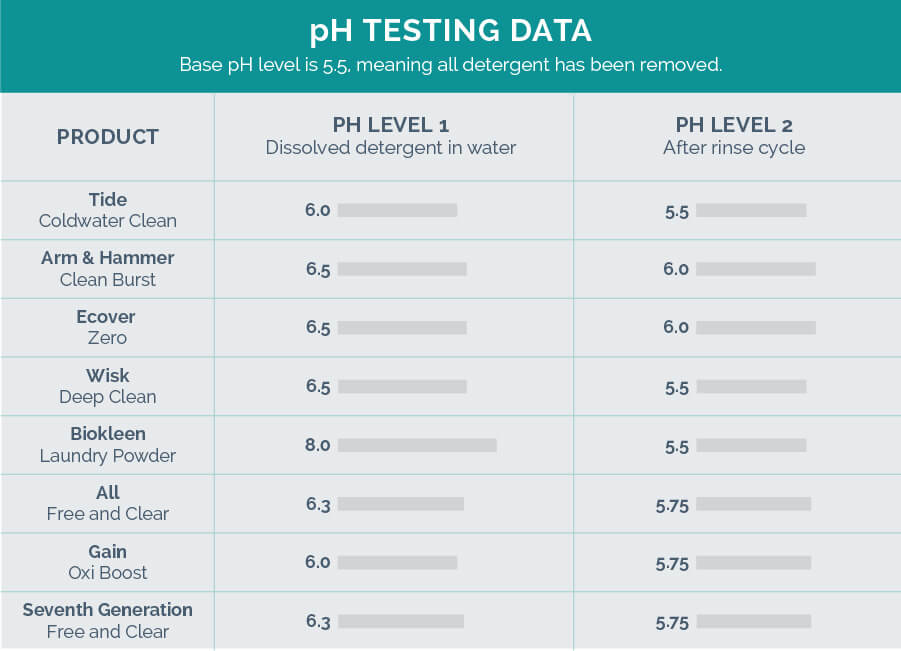
pH stands for “potential of hydrogen”, and is a measure of the hydrogen ion concentration in a liquid solution. The pH scale ranges from 0 to 14. A pH of 7 is neutral. The lower the number, the more acidic it is, while the higher it is, the more alkaline it is.
Detergents are more effective when they are alkaline, so we wanted to test the pH of the different detergents using pH strips. We also wanted to see which detergent had the lowest pH level after washing, indicating that the detergent had left behind a minimum of excess laundry detergent.
In order to test this, we measured the correct amount of detergent for a medium-sized load and took a sample of the dissolved water to test its pH level. After the cleaning cycle ended and the rinse cycle began, we obtained another sample of the water and again measured the pH level. We repeated this process for each of our finalist detergents.
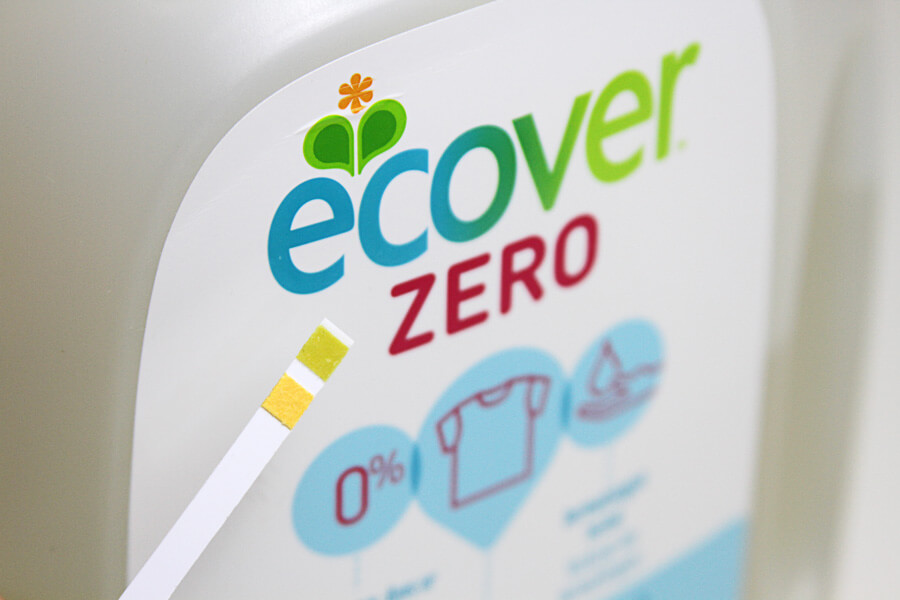
Typically, water is normally somewhere between 6.5 and 8.5 on the pH scale. The water coming out of our washer (with no detergent or clothes) tested at a 5.5 pH level, so this is the level we expected to see the second sample return to in an ideal scenario.
Biokleen was the most alkaline of the detergents we tested, and while this didn’t necessarily translate directly to stain removing potential, it cleans well with the most basic (and pronounceable) ingredients. It was also one of the detergents (along with Tide Coldwater Clean and Wisk Deep Clean) that provided the lowest pH levels during the rinse cycles. This means these detergents had the least amount of excess laundry detergent after the wash cycle.
The price test

For most households, choosing a detergent is a matter of finding the most effective at the best deal. We looked at the average prices of our top finalists at online retails giants like Amazon.com, Target.com, and Walmart.com. Then we divided the lowest price option by the number of loads in each bottle to find the cost per load.
The cost per load ranged from .8 to .29 cents per load, with Arm & Hammer – Clean Burst being the most economical choice. Not far behind was Biokleen Laundry Powder at .11 cents per load. Most of the detergents landed in the .17 to .23 cents per load price range, which gives you several options at the same price point. The most expensive detergent we reviewed was All Free & Clear, a good choice if you don’t mind paying a little more for a premium detergent.
Why use laundry detergent
By itself, water alone will not remove oil and grease from clothing because oil and grease repel water molecules. This is why we need to add laundry detergent. Laundry detergent contains surfactants, which help the water pull away dirt and grease, break it up, and wash it away. Surfactants do another job too. They hold soils and fabric dyes in suspension and prevent them from being redeposited back onto the cleaned laundry.
Laundry detergents remove soils and stains from clothing, but they also disinfect, deodorize, freshen, and brighten fabrics as they clean. The end result are clothes and fabrics that look better and last longer.
Important features to consider
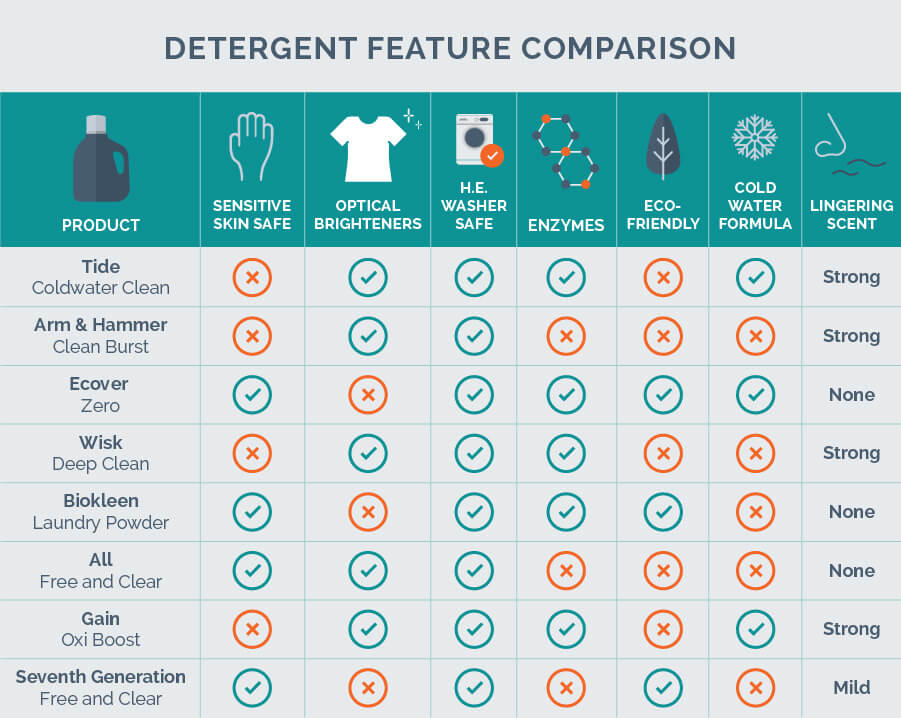
Cost-effective: Americans wash 300 to 390 loads of laundry a year on average. Switching from a premium-priced to a more inexpensive detergent can help you save $50 a year. If you live in a larger household with more laundry, the savings can be even greater.
Versatile: A laundry detergent that is effective in all temperatures gives you the option to wash your clothes in cold water without sacrificing cleanliness. Generally available at the same price point, detergents formulated to wash in cold water save energy, prevent shrinking and fading and keep dark clothes from bleeding dye onto lighter items. Cold water detergents can also be used in warm and hot water, so you can change temperatures without needing to change detergents.
Sensitive skin: Dyes and fragrances can cause rashes and skin allergies in certain individuals. Dye- and perfume-free laundry detergents (which often have the phrase “free and clear” on the label) are the best to use if you have sensitive skin or baby laundry to do.
Eco-friendly: All chemicals are added to detergents for a specific purpose, but some companies position themselves as eco-friendly. They avoid chemicals that are categorized as potentially harmful to our health and environment by the Environmental Protection Agency and/or the Environmental Working Group.
Scent: A lingering scent on your clean clothes tends to be a love it or hate it option. The best smelling laundry detergent for one person may be overpowering and unpleasant for another. When it comes to laundry detergent, you have lots of choices, from free and clear to heavily scented.
HE safe: If you have a front-loading washer or high-efficiency top-loader, you’ll want to use a detergent specifically labeled for high-efficiency (HE) machines.
How do laundry detergents work?
Laundry detergents are made up of surfactants and builders. We went into detail about types of stains and how to remove them on our laundry stain remover review. Here’s a quick chemistry lesson to explain how surfactants (short for “surface active agents”) are the most important part of any cleaning agent.
Surfactants are long molecules with a water-loving (hydrophilic) head and a grease-loving (hydrophobic) tail. The attractive forces between the head and water cause the grease to be lifted from the surface, surrounded by detergent molecules, and washed away by the water. Surfactants reduce the surface tension of water so that a cleaning solution can better penetrate the clothes and loosen particles and soil.
There are different types of surfactants that can be found in laundry detergents:
- Mineral-based
- Synthetic
- Plant-based
Builders enhance the efficiency of the surfactant, primarily by reducing the hardness of the water. They also maintain alkalinity, which helps to remove acidic, fatty, and oily soils, and keeps soils from redepositing during the wash cycle.
According to a professor at the University of Maryland, half of the liquid laundry detergents on the market use enzymes in conjunction with surfactants. While not necessary, enzymes are especially effective in removing protein from clothes.
Detergents usually only contain one type of enzyme, though some have two or three. Proteases are effective on protein-based stains such as blood or egg, amylases help break down starch-based stains, and lipases break down fats and grease. Enzymes occur naturally in our environments and work in the same way as enzymes do in the body.
Optical brighteners are used to make the fabric look whiter by increasing the overall amount of blue light reflected. In the past, bluing was used to achieve the same effect. Instead of a blue dye, optical brighteners deposit reflective particles onto fabrics. Some brighteners can cause allergic reactions to those with sensitive skin, but for most, it isn’t a problem.
There is some concern that optical brighteners have a negative environmental impact, but the Environmental Protection Agency lists several optical brighteners on their Safer Chemical Ingredients List, and categorizes them as “not associated with a low level of hazard concern for all human health and environmental endpoints”. Since optical brighteners decompose relatively slowly and have fluorescent properties, they do serve as an useful indicator in pollution screening.
Some companies, such as Seventh Generation, Ecover and Biokleen make it a company policy not to use optical brighteners.
Liquid vs. powder detergent

Liquid detergent
Pros: Liquids dissolve better in both warm and cold water, making them more energy-efficient. They work well on food, grease, and oils. As liquids, they are also good for pretreating stains.
Cons: Consumer Reports found that confusing markings on caps (meant to indicate different load sizes and machine types) can cause you to use too much detergent, leading to wasted detergent and longer rinse cycles.
Powder detergent
Pros: Surfactants are more stable in powders, so they have a longer shelf life than liquid detergents. This means you can buy in bulk (which saves money and cuts down on excess packaging) without it becoming ineffective over time. They are especially effective on ground-in dirt, making them ideal for children’s play clothes.
Cons: Powders dissolve better in warm water, which uses more energy than cold water. If not measured correctly, it can also leave behind residue.
What is hard water?
Hard water contains minerals such as calcium (Ca), magnesium (Mg), iron (Fe) and manganese (Mn). According to the U.S. Geological Survey, hard water is not a health concern, but it can cause detergents to perform poorly and shorten the life of fabric and clothes. It affects 85% of households in the United States and is an important consideration when choosing a detergent, because the minerals chemically interact with the surfactants in detergents, making them less effective.
If you suspect that you have hard water, you can take a sample to be tested at your local pet supply or pool supply store. It’s also easy to test yourself with a water strip test. It’s best to test the water directly out of your washer, and to test both your cold and hot water since hot water heaters can produce a higher mineral content. The strip tests for hardness from 0 to 1,000 ppm (parts per million), and you can refer to the degree of hardness standard as established by the American Society of Agricultural Engineers and the Water Quality Association to determine if and how you need to treat your water.
If you find you do have hard water, you can treat it by adding a water softener to your wash cycle. For slightly or moderately hard water, you may want to add half a cup to three fourths of a cup of Borax water softener to your laundry. For very hard water, Calgon water softener is recommended as it targets a wider range of minerals.
High efficiency (HE) washing machines
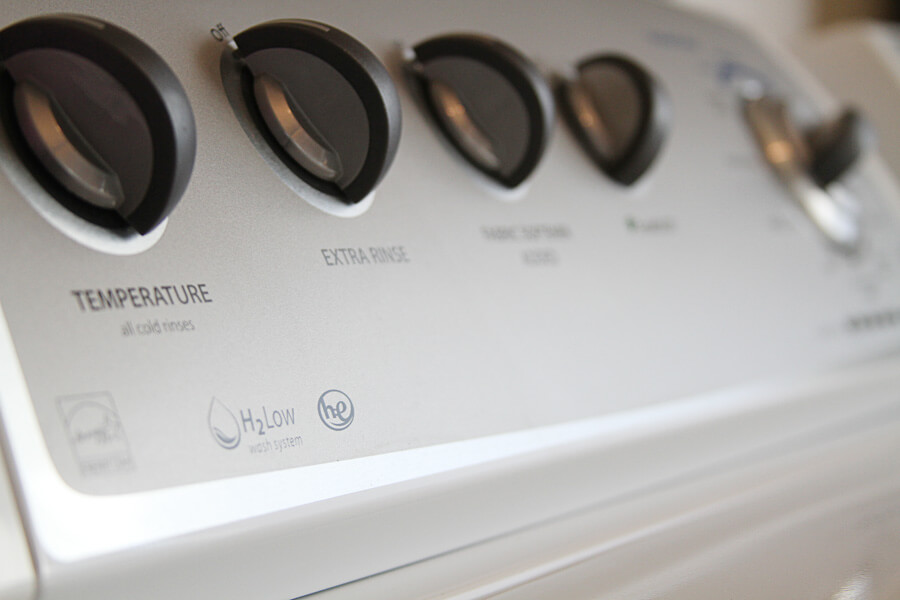
High efficiency washing machines are gaining in popularity because they use less water, spin faster, and get clothes cleaner than traditional washing machines. The savings in water (up to 66%) and therefore, energy (up to 50%) translates to both long-term cost savings and environmental benefits.
Since HE washing machines work in a completely different way than a traditional washing machine, it’s important to choose an HE laundry detergent for use in one. While you may have heard that it’s okay to “use less” of a non-HE detergent, this is problematic for several reasons.
- Traditional laundry detergents can impact proper cleaning by creating a cushion of excess suds between the surfactants and the soil, which prevents the detergent from being able to grab the soil and remove it.
- The use of a non-HE detergent in your HE machine mashing can invalidate the warranty.
- The soil can’t be removed without the appropriate levels of detergent, leaving you with dirty clothes. (You should always use the recommended amount based on the size of your load. The detergent may also specify different volumes for HE and traditional washers.)
Due to low water levels in an HE washer during the wash and rinse cycles, HE detergents must work differently from traditional laundry detergents. They are formulated to be low-sudsing and quick-dispersing to make the most of your HE washer. They also need to be able to hold soils in low water volumes, so they don’t redeposit onto your clean clothes.
DIY laundry detergents
You’ve seen the tutorials for DIY laundry detergent all over Pinterest. For budget-minded and environmentally-conscious consumers, you have to admit they look pretty appealing. They use only a few simple ingredients that you can easily pronounce, and can be as cheap as $.02 per load. If they truly live up to their claims, they’d be the most cost-effective and eco-friendly option out there, but how well do they really work?
After taking a closer look at the recipes, we found that DIY laundry detergents don’t live up to the hype. It’s one of those cases where if it sounds too good to be true, it probably is. The problem has to do with using soap.
Most homemade detergents call for a combination of:
Water softeners: Borax, washing soda and baking soda are generally recommended to soften hard water, which allows the cleaning agent to pull out and trap soil. It’s worth noting that baking soda doesn’t actually soften water, but it may work as a booster.
Boosters: While we highly recommend OxiClean as an oxygen-based stain remover, boosters like OxiClean or OxoBrite are intended to aid a cleaning agent in whitening or stain removal, not replace it.
Soap: Some recipes don’t even contain a cleaning agent at all. Most call for you to grate or melt soaps like Fels Naptha (meant for pre-treating stains), castile soaps, or other various soaps into the detergent.
While water softeners and boosters make sense in a laundry detergent, the ratio of booster to cleaning agent (soap) in these recipes leaves you with a large proportion of ingredients meant to be additives and which give you very little actual cleaning power.
However, the real issue with DIY laundry detergents is that soap uses oil-based surfactants which don’t rinse clean from cloth fibers. Because it does not rinse away easily, soap can leave visible residue on your clothing and the inside of your washing machine. Just imagine the soap scum that builds up in the shower. Do you really want that in the fibers of your clothes?
Depending on what drew you to use a DIY laundry detergent, you’re better off finding a commercial laundry detergent that meets your needs. For instance, if you like the idea of using a more natural product, a plant-based detergent like Ecover – Zero could work for you. If the low cost factor drew you in, there are several inexpensive options that will help you save money.
The bottom line
When it comes to dirty laundry, buyers look for a detergent that balances performance and price. Tide – Coldwater Clean comes in as our top choice for its ability to brighten clothes and lighten tough stains and at a price that compares with most of the other detergents we reviewed. While Wisk – Deep Clean was also a great stain remover, once we factored in the energy savings and versatility of Tide – Coldwater Clean, it was our clear winner.
More Reviews
Rowenta - DW5280 Focus
Puracy - Natural
BEAUTURAL
The Best Laundry Stain Removers
OxiClean - Versatile Stain Remover
Iron Out - Stain Remover
Brawny - Pick-A-Size
DELOMO - Pet Hair Roller
Shark - NV350
Dyson - V15 Detect
Rubbermaid - Roughneck


